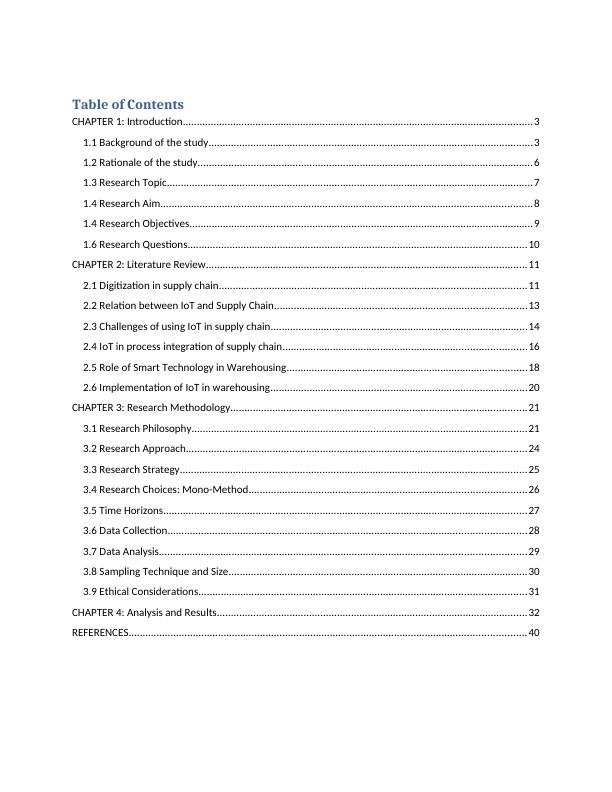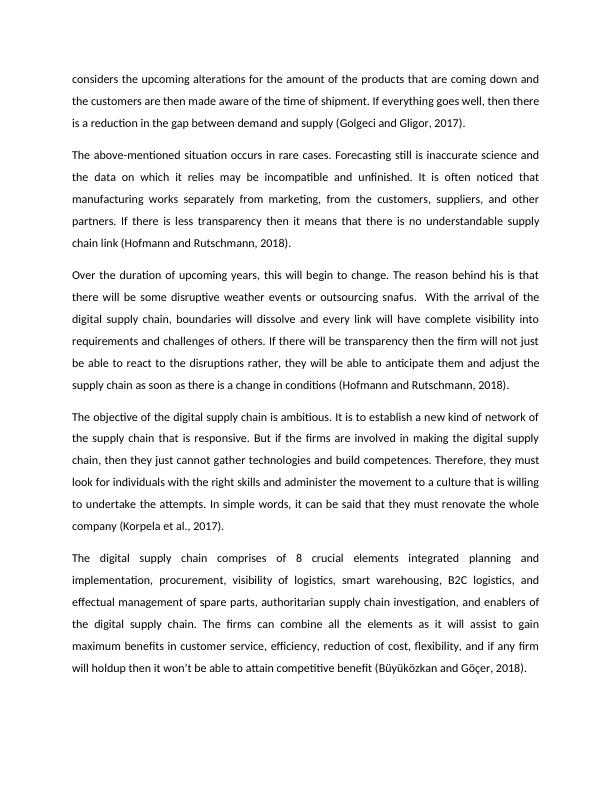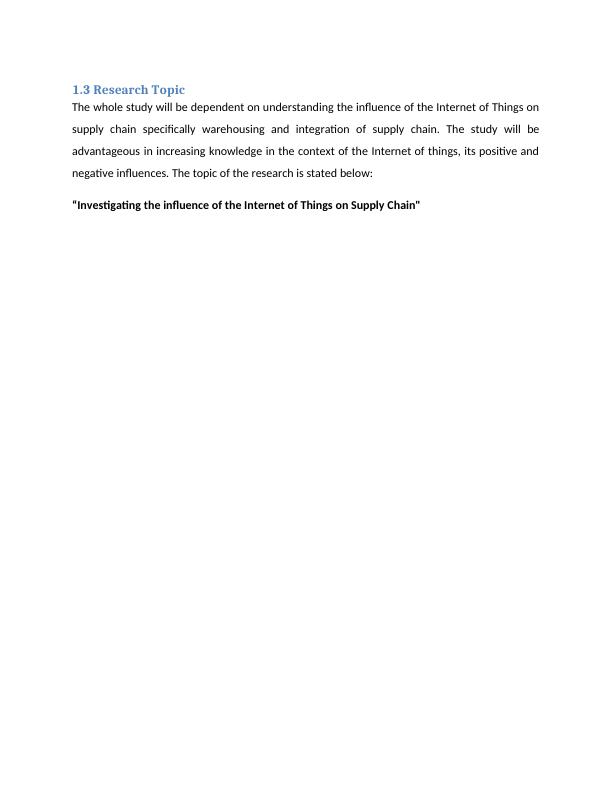Digitization in supply chain PDF
Added on 2021-11-19
45 Pages12677 Words200 Views
Dissertation

Table of Contents
CHAPTER 1: Introduction............................................................................................................................. 3
1.1 Background of the study....................................................................................................................3
1.2 Rationale of the study........................................................................................................................ 6
1.3 Research Topic................................................................................................................................... 7
1.4 Research Aim..................................................................................................................................... 8
1.4 Research Objectives........................................................................................................................... 9
1.6 Research Questions......................................................................................................................... 10
CHAPTER 2: Literature Review................................................................................................................... 11
2.1 Digitization in supply chain.............................................................................................................. 11
2.2 Relation between IoT and Supply Chain..........................................................................................13
2.3 Challenges of using IoT in supply chain............................................................................................14
2.4 IoT in process integration of supply chain.......................................................................................16
2.5 Role of Smart Technology in Warehousing......................................................................................18
2.6 Implementation of IoT in warehousing............................................................................................20
CHAPTER 3: Research Methodology.......................................................................................................... 21
3.1 Research Philosophy........................................................................................................................ 21
3.2 Research Approach.......................................................................................................................... 24
3.3 Research Strategy............................................................................................................................ 25
3.4 Research Choices: Mono-Method...................................................................................................26
3.5 Time Horizons.................................................................................................................................. 27
3.6 Data Collection................................................................................................................................ 28
3.7 Data Analysis................................................................................................................................... 29
3.8 Sampling Technique and Size........................................................................................................... 30
3.9 Ethical Considerations..................................................................................................................... 31
CHAPTER 4: Analysis and Results............................................................................................................... 32
REFERENCES.............................................................................................................................................. 40
CHAPTER 1: Introduction............................................................................................................................. 3
1.1 Background of the study....................................................................................................................3
1.2 Rationale of the study........................................................................................................................ 6
1.3 Research Topic................................................................................................................................... 7
1.4 Research Aim..................................................................................................................................... 8
1.4 Research Objectives........................................................................................................................... 9
1.6 Research Questions......................................................................................................................... 10
CHAPTER 2: Literature Review................................................................................................................... 11
2.1 Digitization in supply chain.............................................................................................................. 11
2.2 Relation between IoT and Supply Chain..........................................................................................13
2.3 Challenges of using IoT in supply chain............................................................................................14
2.4 IoT in process integration of supply chain.......................................................................................16
2.5 Role of Smart Technology in Warehousing......................................................................................18
2.6 Implementation of IoT in warehousing............................................................................................20
CHAPTER 3: Research Methodology.......................................................................................................... 21
3.1 Research Philosophy........................................................................................................................ 21
3.2 Research Approach.......................................................................................................................... 24
3.3 Research Strategy............................................................................................................................ 25
3.4 Research Choices: Mono-Method...................................................................................................26
3.5 Time Horizons.................................................................................................................................. 27
3.6 Data Collection................................................................................................................................ 28
3.7 Data Analysis................................................................................................................................... 29
3.8 Sampling Technique and Size........................................................................................................... 30
3.9 Ethical Considerations..................................................................................................................... 31
CHAPTER 4: Analysis and Results............................................................................................................... 32
REFERENCES.............................................................................................................................................. 40

CHAPTER 1: Introduction
1.1 Background of the study
In order to realize the vision of industry 4.0, the procedures of most of the firms have to
become digitized. The most essential element will be the evolution of conventional supply
chains towards a smart, connected, and extremely effectual supply chain ecosystem. The supply
chain is a series of largely discrete, siloed steps that are taken with the help of marketing,
product development, manufacturing, distribution and finally in hands of the end-user
(Tjahjono et al., 2017). With the help of digitization, all those walls can be brought down and
the chain can become an entire incorporated ecosystem which is transparent to all the
individuals involved right from the supplier of raw materials, parts, and components to the
transporters of those supplies and finished products and lastly to the customers that have the
demand for accomplishment (Tjahjono et al., 2017).
The network is reliant on numerous technologies: included planning and implementation
systems, visibility of logistics, self-directed logistics, smart procurement and warehousing,
management of spare parts, and sophisticated investigative. With the help of this outcome, the
companies will be able to react to the disruptions in the supply chain and also will be able to
anticipate them by completely modeling the networking, creating the scenarios of what if, and
making adjustments in the real-time supply change as per the change in circumstances
(Manavalan and Jayakrishna, 2019).
Once it is established, the components initiate to develop the digital supply network that will
offer a novelty degree of resiliency and receptiveness which enables the firm to attain
competitive advantage and deliver the most effectual and transparent service delivery to the
customers (Manavalan and Jayakrishna, 2019).
At most of the firms, the products are given to the customers by following a standard
procedure. Marketing analyzes what are the requirements of the customers and then tries to
assume sales for the upcoming duration. With the help of that information, raw materials,
parts, and components are ordered by manufacturing for predictable capacity. Distribution
1.1 Background of the study
In order to realize the vision of industry 4.0, the procedures of most of the firms have to
become digitized. The most essential element will be the evolution of conventional supply
chains towards a smart, connected, and extremely effectual supply chain ecosystem. The supply
chain is a series of largely discrete, siloed steps that are taken with the help of marketing,
product development, manufacturing, distribution and finally in hands of the end-user
(Tjahjono et al., 2017). With the help of digitization, all those walls can be brought down and
the chain can become an entire incorporated ecosystem which is transparent to all the
individuals involved right from the supplier of raw materials, parts, and components to the
transporters of those supplies and finished products and lastly to the customers that have the
demand for accomplishment (Tjahjono et al., 2017).
The network is reliant on numerous technologies: included planning and implementation
systems, visibility of logistics, self-directed logistics, smart procurement and warehousing,
management of spare parts, and sophisticated investigative. With the help of this outcome, the
companies will be able to react to the disruptions in the supply chain and also will be able to
anticipate them by completely modeling the networking, creating the scenarios of what if, and
making adjustments in the real-time supply change as per the change in circumstances
(Manavalan and Jayakrishna, 2019).
Once it is established, the components initiate to develop the digital supply network that will
offer a novelty degree of resiliency and receptiveness which enables the firm to attain
competitive advantage and deliver the most effectual and transparent service delivery to the
customers (Manavalan and Jayakrishna, 2019).
At most of the firms, the products are given to the customers by following a standard
procedure. Marketing analyzes what are the requirements of the customers and then tries to
assume sales for the upcoming duration. With the help of that information, raw materials,
parts, and components are ordered by manufacturing for predictable capacity. Distribution

considers the upcoming alterations for the amount of the products that are coming down and
the customers are then made aware of the time of shipment. If everything goes well, then there
is a reduction in the gap between demand and supply (Golgeci and Gligor, 2017).
The above-mentioned situation occurs in rare cases. Forecasting still is inaccurate science and
the data on which it relies may be incompatible and unfinished. It is often noticed that
manufacturing works separately from marketing, from the customers, suppliers, and other
partners. If there is less transparency then it means that there is no understandable supply
chain link (Hofmann and Rutschmann, 2018).
Over the duration of upcoming years, this will begin to change. The reason behind his is that
there will be some disruptive weather events or outsourcing snafus. With the arrival of the
digital supply chain, boundaries will dissolve and every link will have complete visibility into
requirements and challenges of others. If there will be transparency then the firm will not just
be able to react to the disruptions rather, they will be able to anticipate them and adjust the
supply chain as soon as there is a change in conditions (Hofmann and Rutschmann, 2018).
The objective of the digital supply chain is ambitious. It is to establish a new kind of network of
the supply chain that is responsive. But if the firms are involved in making the digital supply
chain, then they just cannot gather technologies and build competences. Therefore, they must
look for individuals with the right skills and administer the movement to a culture that is willing
to undertake the attempts. In simple words, it can be said that they must renovate the whole
company (Korpela et al., 2017).
The digital supply chain comprises of 8 crucial elements integrated planning and
implementation, procurement, visibility of logistics, smart warehousing, B2C logistics, and
effectual management of spare parts, authoritarian supply chain investigation, and enablers of
the digital supply chain. The firms can combine all the elements as it will assist to gain
maximum benefits in customer service, efficiency, reduction of cost, flexibility, and if any firm
will holdup then it won’t be able to attain competitive benefit (Büyüközkan and Göçer, 2018).
the customers are then made aware of the time of shipment. If everything goes well, then there
is a reduction in the gap between demand and supply (Golgeci and Gligor, 2017).
The above-mentioned situation occurs in rare cases. Forecasting still is inaccurate science and
the data on which it relies may be incompatible and unfinished. It is often noticed that
manufacturing works separately from marketing, from the customers, suppliers, and other
partners. If there is less transparency then it means that there is no understandable supply
chain link (Hofmann and Rutschmann, 2018).
Over the duration of upcoming years, this will begin to change. The reason behind his is that
there will be some disruptive weather events or outsourcing snafus. With the arrival of the
digital supply chain, boundaries will dissolve and every link will have complete visibility into
requirements and challenges of others. If there will be transparency then the firm will not just
be able to react to the disruptions rather, they will be able to anticipate them and adjust the
supply chain as soon as there is a change in conditions (Hofmann and Rutschmann, 2018).
The objective of the digital supply chain is ambitious. It is to establish a new kind of network of
the supply chain that is responsive. But if the firms are involved in making the digital supply
chain, then they just cannot gather technologies and build competences. Therefore, they must
look for individuals with the right skills and administer the movement to a culture that is willing
to undertake the attempts. In simple words, it can be said that they must renovate the whole
company (Korpela et al., 2017).
The digital supply chain comprises of 8 crucial elements integrated planning and
implementation, procurement, visibility of logistics, smart warehousing, B2C logistics, and
effectual management of spare parts, authoritarian supply chain investigation, and enablers of
the digital supply chain. The firms can combine all the elements as it will assist to gain
maximum benefits in customer service, efficiency, reduction of cost, flexibility, and if any firm
will holdup then it won’t be able to attain competitive benefit (Büyüközkan and Göçer, 2018).

The pandemic has influenced the global supply chain to a major extent, which later requires
quick action from the logistic firms that are willing to continuously drive growth in this
situation. For these kinds of firms, new technology acts as a key resource. The Internet of
Things comprises smart devices that move or receive data with the help of the internet. The
sensors of IoT are an essential part of what the analysts call Industry 4.0, the present trend
towards digitization in manufacturing and logistics. It is noticed that this year Industrial IoT
devices have majorly influenced how the cutting-edge logistics operations move towards their
work (Tjahjono et al., 2017). This demonstrates that these alterations are just the beginning of a
major revolution that will occur in the rest of the year.
One of the major changes that have enhanced the adoption of IoT powered fleet administration
technology. If the company has the right sensors then it can gather real-time data on the
movement of the vehicle and share it will the parties who are part of it. The logistic firms that
have large fleets can manage their vehicles through fleet management technology in a manner
in which it helps in the promotion of safety and sustainability (Haddud et al., 2017). The best
example of this is that a firm can install IoT sensors in the truck which will help in tracking
variables like location, speed, acceleration, and status of the engine. With the help of this data,
one can detect when the vehicles are inactive for a longer duration of time. This is precious
data for the business that have their trucks operating in cities where there are restrictions on
commercial vehicle idling. In addition to this, the logistic firms are also making use of this
technology to optimize routes of the vehicle and decrease the cost of spending on fuel. These
extra advantages can help to make a sector stronger that has faced many weaknesses within its
supply chains. The data from IoT sensors in the vehicles can also give a detailed review of the
supply chain (Haddud et al., 2017).
quick action from the logistic firms that are willing to continuously drive growth in this
situation. For these kinds of firms, new technology acts as a key resource. The Internet of
Things comprises smart devices that move or receive data with the help of the internet. The
sensors of IoT are an essential part of what the analysts call Industry 4.0, the present trend
towards digitization in manufacturing and logistics. It is noticed that this year Industrial IoT
devices have majorly influenced how the cutting-edge logistics operations move towards their
work (Tjahjono et al., 2017). This demonstrates that these alterations are just the beginning of a
major revolution that will occur in the rest of the year.
One of the major changes that have enhanced the adoption of IoT powered fleet administration
technology. If the company has the right sensors then it can gather real-time data on the
movement of the vehicle and share it will the parties who are part of it. The logistic firms that
have large fleets can manage their vehicles through fleet management technology in a manner
in which it helps in the promotion of safety and sustainability (Haddud et al., 2017). The best
example of this is that a firm can install IoT sensors in the truck which will help in tracking
variables like location, speed, acceleration, and status of the engine. With the help of this data,
one can detect when the vehicles are inactive for a longer duration of time. This is precious
data for the business that have their trucks operating in cities where there are restrictions on
commercial vehicle idling. In addition to this, the logistic firms are also making use of this
technology to optimize routes of the vehicle and decrease the cost of spending on fuel. These
extra advantages can help to make a sector stronger that has faced many weaknesses within its
supply chains. The data from IoT sensors in the vehicles can also give a detailed review of the
supply chain (Haddud et al., 2017).

1.2 Rationale of the study
The study of the impact of IoT on the supply chain in the context of warehousing is important
because this is an era of materialization of new digital industrial technology that is known as
industry 4.0. It has a positive influence on the performance of the supply chain. If it is seen in
the context of the supply chain, then warehouses are their basic parts that are used for storing
the products and managing the levels of inventory (Haddud et al., 2017). If the firm has a sound
system of warehouse management then it can help to reduce cost and increase customer
satisfaction. It has come to notice that conventional models of warehouse management have
become less effectual and also not appropriate for today's increasing market demands. The
other reason for conducting the study is that the Internet of Things is becoming a major trend
in today's era. It is the next generation of Internet-connected embedded ICT systems in the
digital atmosphere in order to integrate the supply chain and logistics procedure in a faultless
manner. It can be very unique to amalgamate IoT into the present ICT system because of its
intelligence, independent, and all-encompassing applications (Haddud et al., 2017).
Nevertheless, a study on the adoption of the internet of things in the supply chain is inadequate
and the reception of IoT specifically in retail services has been excessively oratory.
The study of the impact of IoT on the supply chain in the context of warehousing is important
because this is an era of materialization of new digital industrial technology that is known as
industry 4.0. It has a positive influence on the performance of the supply chain. If it is seen in
the context of the supply chain, then warehouses are their basic parts that are used for storing
the products and managing the levels of inventory (Haddud et al., 2017). If the firm has a sound
system of warehouse management then it can help to reduce cost and increase customer
satisfaction. It has come to notice that conventional models of warehouse management have
become less effectual and also not appropriate for today's increasing market demands. The
other reason for conducting the study is that the Internet of Things is becoming a major trend
in today's era. It is the next generation of Internet-connected embedded ICT systems in the
digital atmosphere in order to integrate the supply chain and logistics procedure in a faultless
manner. It can be very unique to amalgamate IoT into the present ICT system because of its
intelligence, independent, and all-encompassing applications (Haddud et al., 2017).
Nevertheless, a study on the adoption of the internet of things in the supply chain is inadequate
and the reception of IoT specifically in retail services has been excessively oratory.

1.3 Research Topic
The whole study will be dependent on understanding the influence of the Internet of Things on
supply chain specifically warehousing and integration of supply chain. The study will be
advantageous in increasing knowledge in the context of the Internet of things, its positive and
negative influences. The topic of the research is stated below:
“Investigating the influence of the Internet of Things on Supply Chain"
The whole study will be dependent on understanding the influence of the Internet of Things on
supply chain specifically warehousing and integration of supply chain. The study will be
advantageous in increasing knowledge in the context of the Internet of things, its positive and
negative influences. The topic of the research is stated below:
“Investigating the influence of the Internet of Things on Supply Chain"

1.4 Research Aim
The purpose of the study is to identify and understand the influence of the internet of things on
the supply chain particularly towards warehousing and performance of the supply chain. The
association between the internet of things and the supply chain will also be demonstrated.
The purpose of the study is to identify and understand the influence of the internet of things on
the supply chain particularly towards warehousing and performance of the supply chain. The
association between the internet of things and the supply chain will also be demonstrated.

End of preview
Want to access all the pages? Upload your documents or become a member.
Related Documents
Research Project on Digital Technology in Supply Chainlg...
|17
|3728
|27